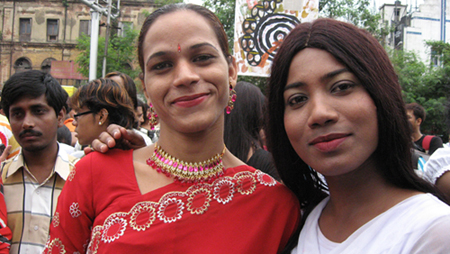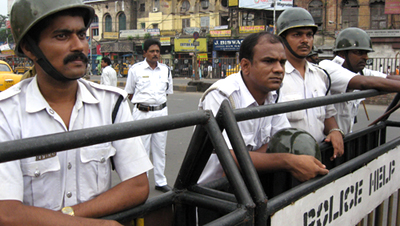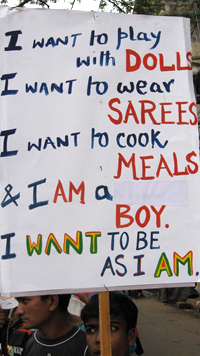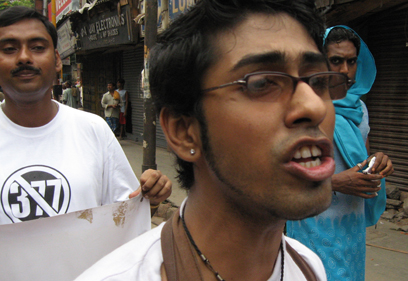 In a city where Monday through Saturday is reserved for a cacophony approaching chaos – street hawkers, thundering traffic horns, temple chants, muezzin calls – Sunday, June 29th, typically a mellow day spent with family, offered little respite for the denizens of Kolkata (Calcutta) in eastern India. As the locals of India’s second largest city began relaxing over chai (milky, spiced tea) on a humid, Sunday afternoon, supporters of Kolkata’s sexual minorities, including lesbians, bisexuals, gays, transgender, Hijras (eunuchs), and heterosexuals took to the streets for a Rainbow Pride Parade.
In a city where Monday through Saturday is reserved for a cacophony approaching chaos – street hawkers, thundering traffic horns, temple chants, muezzin calls – Sunday, June 29th, typically a mellow day spent with family, offered little respite for the denizens of Kolkata (Calcutta) in eastern India. As the locals of India’s second largest city began relaxing over chai (milky, spiced tea) on a humid, Sunday afternoon, supporters of Kolkata’s sexual minorities, including lesbians, bisexuals, gays, transgender, Hijras (eunuchs), and heterosexuals took to the streets for a Rainbow Pride Parade.
Much of India is still deeply conservative, where deviation from tradition is often met with ostracism. Indeed, homosexuality in the Indian subcontinent is illegal. Section 377 of the Indian Penal Code terms homosexuality as "against the order of nature" and if convicted is punishable by up to ten years in prison. While organizers of the Rainbow Pride Week, which began on June 24th and included everything from poster making events to film screenings to the actual parade, admit that only 29 people have been convicted under section 377 since its inception by the British Raj in 1860, they insist that the threat looms large.
 "This is a law that criminalizes any form of sexual intercourse other than peno-vaginal penetration
Its existence allows the police to harass and threaten lesbian, gay, bisexual and transgender people and extort money from them," read a statement handed out by the parade’s organizers.
"This is a law that criminalizes any form of sexual intercourse other than peno-vaginal penetration
Its existence allows the police to harass and threaten lesbian, gay, bisexual and transgender people and extort money from them," read a statement handed out by the parade’s organizers.
Around 170 individuals, from a handful of LGBT, HIV/AIDS, and sexual health organizations, gathered at College Square near Presidency College in the northern part of the city to start the three kilometer walk.
Souvik Ghosh, a 23-year-old Kolkata local who works for the Indian NGO SAATHI (Solidarity and Action Against HIV Infection in India), was leading a contingent of protesters in the cheer: "One, two, three, four, 377, NO MORE!"
"We are here to primarily revise section 377 of the Indian Penal Code. It hampers our human rights," he said.
 Mr. Ghosh, who organizes HIV educational initiatives in the remote northeastern states of India, explained that much of India is ignorant of sexual minorities.
Mr. Ghosh, who organizes HIV educational initiatives in the remote northeastern states of India, explained that much of India is ignorant of sexual minorities.
"People are in the dark," he added between chants. "That’s why we are doing the march. If the population accepted us, then we wouldn’t need to be here."
Rainbow Pride Parades occur across the world on June 29th. The date memorializes when police raided a gay bar in the Greenwich Village neighborhood of New York City in 1969. In major cities such as San Francisco, Berlin, and Paris, the Rainbow Pride Parades are just that: parades. The mood is festive. Participants are there to celebrate sexual diversity and expression. They are often like massive parties. Yet, while sexual minorities have started to come out into the open in North America and Western Europe, encouraged by same-sex marriage laws and their society’s generally more tolerant attitudes, the marches in India were protests more than parades.
"Pride in India is at a stage where it’s not just pure celebration, it’s always part protest. A reminder of how difficult things are," said Gautam Bhan, a writer and gay rights activist involved with organizing India’s protests, in an interview with the Associated Press.
 This sentiment became evident as the predominantly male participants, some dressed in flowing Indian men’s wear such as kurtas and pyjamas, others in wrapped in marmalade-colored saris, and still more in western-style miniskirts or jeans, walked through downtown Kolkata brandishing "Smash Sexism" pickets and rainbow colored cloth. It is not that there was violence or homophobic, "family values" counter protests, or even any hecklers. Rather taxis, hand-pulled rickshaws, streetcars, and bystanders stopped for that very patriarchal form of observation: the jaw-dropped-to-the-sidewalk gaze.
This sentiment became evident as the predominantly male participants, some dressed in flowing Indian men’s wear such as kurtas and pyjamas, others in wrapped in marmalade-colored saris, and still more in western-style miniskirts or jeans, walked through downtown Kolkata brandishing "Smash Sexism" pickets and rainbow colored cloth. It is not that there was violence or homophobic, "family values" counter protests, or even any hecklers. Rather taxis, hand-pulled rickshaws, streetcars, and bystanders stopped for that very patriarchal form of observation: the jaw-dropped-to-the-sidewalk gaze.
"Like women, we’re not safe in Calcutta after 10 pm. The Rainbow Pride Parade is really about visibility," said 30-year-old Sanjay Ram, founder and secretary general of Kaushish Ek Asha (Bengali for "Try Hope").
Mr. Ram, whose NGO performs outreach work with the LGBTH community in Kolkata, readily admitted that the situation for sexual minorities is improving. He cited the fact that in 1999, at Kolkata’s (and India’s) first Rainbow Pride Parade, only about 50 people showed. In his opinion, the cosmopolitanism of New Delhi and Mumbai offer much more accepting environments for sexual minorities. Nevertheless, he emphasized that in Kolkata awareness is the main issue.
"Back when I went to Kolkata University, I was made to feel unnatural, that the gods had made me wrongly. That’s why I do outreach work, why I founded Kaushish Ek Asha, and why I am here today."
As the parade reached its ending point at Esplanade East, across from the crumbling art deco Metro Cinema hall, a stage was opened for Kolkata’s LGBTH to address the crowd in the city center.
Though some attended the Rainbow Pride Parade to primarily denounce Section 377 and others to raise the profile of sexual minorities in India, activist and Kolkata’s primary organizer, Anis Rai Choudhury, seemed to summarize why so many locals decided to take to Kolkata’s grimy, Victorian-era streets rather than enjoy another quiet Sunday afternoon at home.
"We are proud to be who we are!" Mr. Choudhury shouted in Bengali. "Society has no right to stigmatize us."
